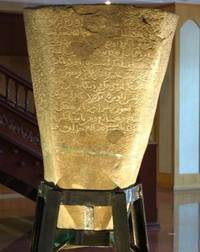BATU BERSURAT TERENGGANU
31 JULAI 2009

Batu Bersurat Terengganu merupakan bukti terawal tulisan Jawi (tulisan berdasarkan abjad Arab) di dunia Islam Melayu, Asia Tenggara. Dengan kedatangan Islam ke rantau ini pada abad ke-10 atau ke-11, cara hidup berpandukan ajaran Al-Quran dan Hadis (seperti yang diamalkan oleh Nabi) berkembang luas di Asia Tenggara. Begitu juga halnya dengan penggunaan tulisan Jawi. Justeru, ia merupakan titik permulaan zaman celik huruf. Saudara baru yang memeluk agama Islam secara beransur ansur menggantikan tulisan Hindu dengan Jawi dalam mengungkapkan kepercayaan baru mereka. Sebagai bukti kepada penyebaran Islam yang bermula dari Timur Tengah, Batu Bersurat Terengganu bukan sekadar imbasan hidup rakyat pada era tersebut bahkan lebih dari itu. Artifak bersejarah ini juga menggambarkan perkembangan kebudayaan Islam yang semakin meningkat di bawah undang-undang agama. Ciri yang seiring dengan pergerakan bersejarah ini adalah pertumbuhan perdagangan maritim yang berpusat di sekitar Kuala Berang iaitu tempat di mana Batu Bersurat Terengganu telah dijumpai. Batu Bersurat ini merekodkan perkembangan perdagangan serantau semasa proses Islamisasi dan menggambarkan corak perdagangan serta pergerakan masyarakat pada masa tersebut. Walaupun agama Islam diterima meluas di Terengganu, ini bukan bermakna pengakhiran kepada cara hidup yang sebelumnya. Batu Bersurat menjadi saksi kepada pembaharuan cara berfikir dan ia tidak menjejaskan cara kehidupan sebelum ini. Walau bagaimanapun, terdapat juga beberapa istilah Sanskrit di Batu Bersurat ini, sebagai memori kepada kewujudan Hindu di Asia Tenggara pada masa lalu.
INSCRIBED STONE OF TERENGGANU
31 JULY 2009
The Inscribed Stone of Terengganu constitutes the earliest evidence of Jawi writing (writing based on Arabic alphabets) in the Malaya Muslim world of Southeast Asia. With the advent of Islam into theregion in the 10th or 11th Century, a life based on the teachings of Al-Quran and the Hadith (practices of the Prophet) became widespread in Southeast Asia and together with this, the use of the Jawi script. Thus, it heralded a new age of literacy, when converts to the new faith gradually replaced the previous Hindu derived script with Jawi, in expressing their new belief. As a testimony to the spread of Islam that emanated from the Middle East, the Inscribed Stone offers more than just a glimpse of the life of the people of the era. This historical artefact also depicted the growing Islamic culture subsumed under a set of religious laws. A concomitant feature of this historic movement was the growth of maritime commerce that centred on Kuala Berang, the place where the The Inscribed Stone of Terengganu was found. The Inscribed Stone alludes to regional trade that flourished in the course of Islamization, with its trading pattern and movement of peoples during that time. While the Islamization of Terengganu was pursued effectively, it did not put an end to the old way of life. The Inscribed Stone of Terengganu bears witness to the new way of thinking that did not jeopardize their previous way of life unnecessarily. However, the Inscribed Stone also contained a number of Sanskrit terms, a memorial to Southeast Asia’s Hindu past.
